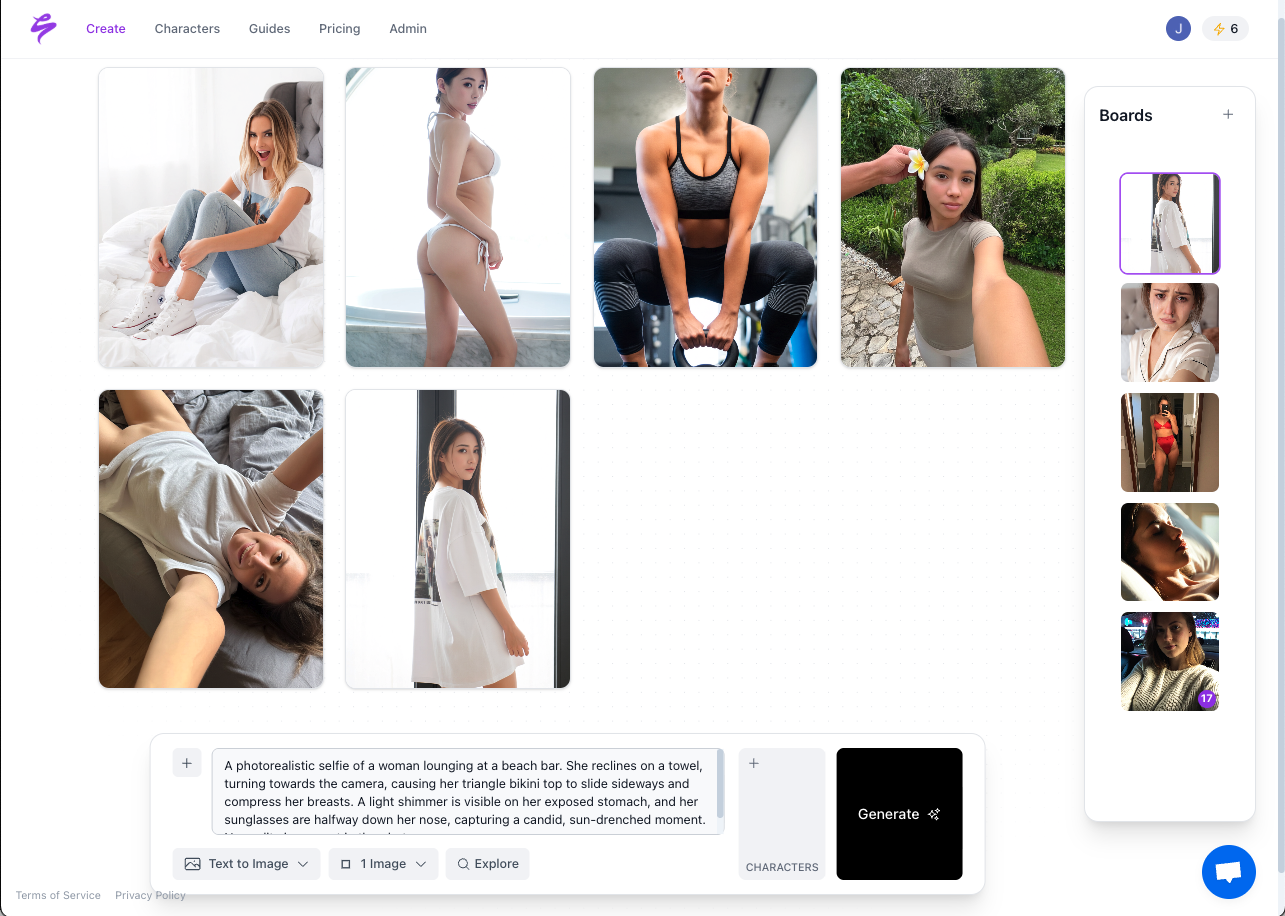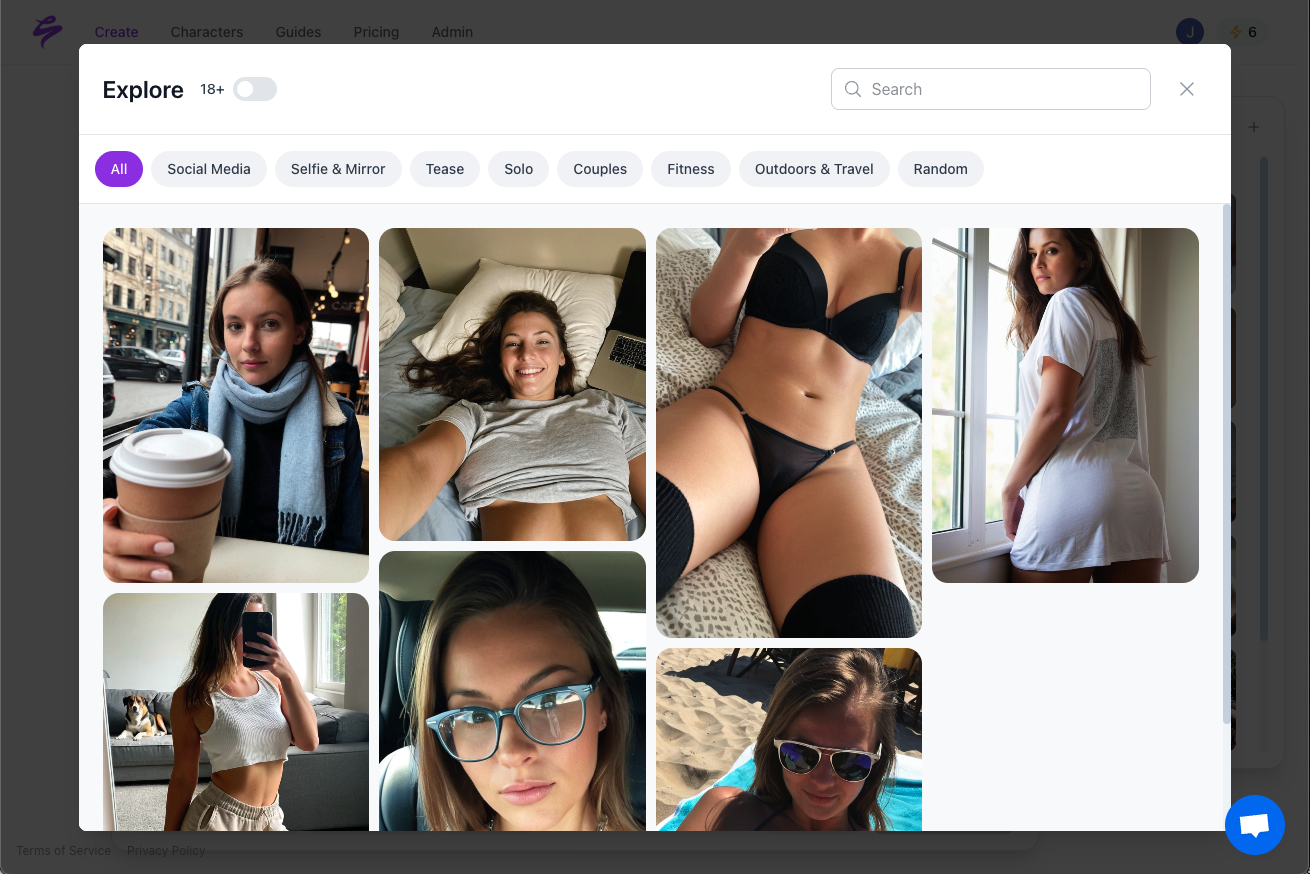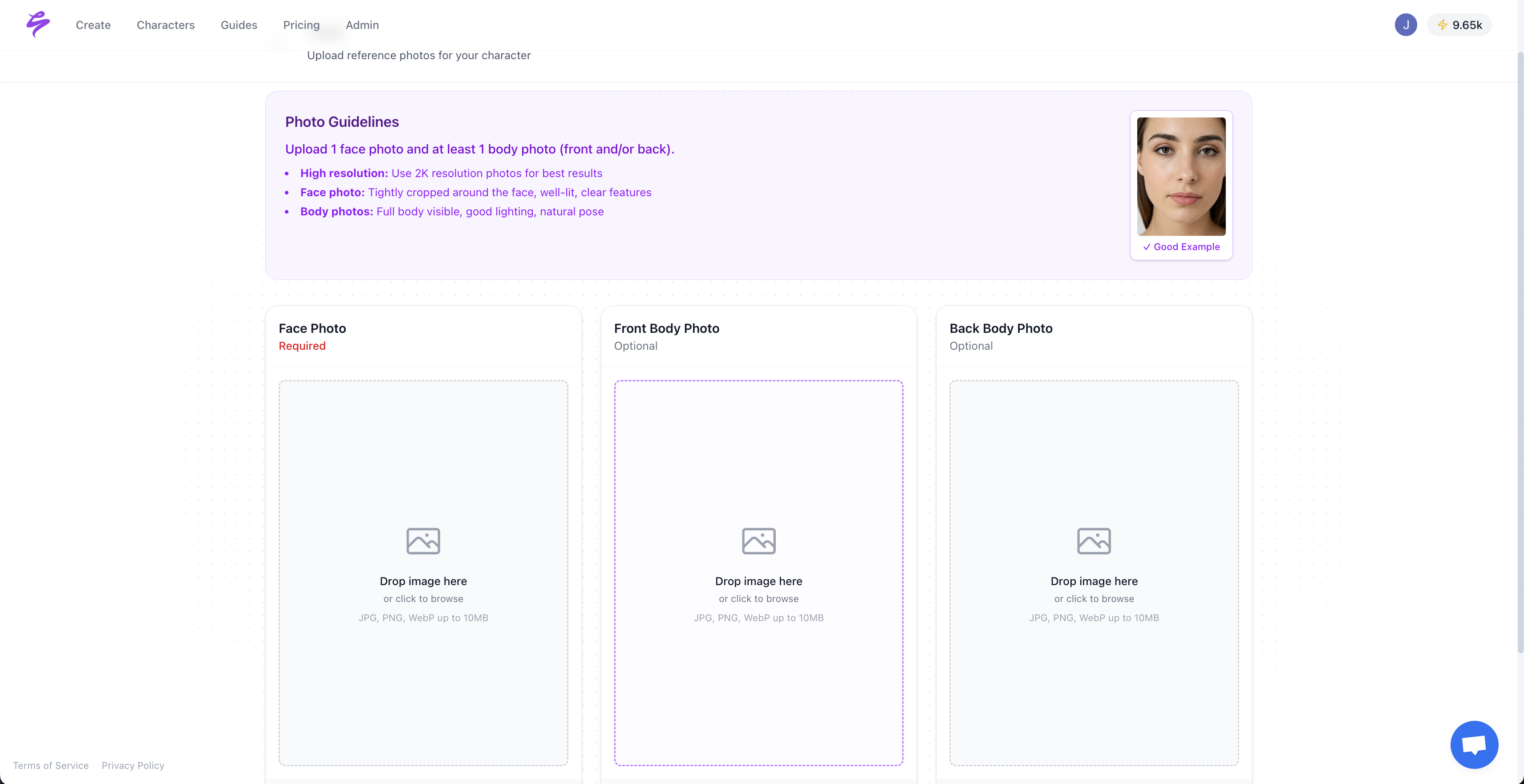Executive summary
- AI photo studios help creators meet rising content demand without constant photoshoots or travel.
- Pykaso and similar tools reduce production time and cost while improving realism, consistency, and creative flexibility.
- Sozee.ai focuses specifically on monetizable creator workflows, including SFW and NSFW funnels and multi-platform output.
- Virtual influencers and agencies gain scalable, consistent pipelines that operate independently of creator availability.
- Creators who adopt AI photo studios early can increase content volume, protect their energy, and grow revenue more efficiently.
The Content Crisis: Why Influencers Need AI Photo Studios
The modern creator economy runs on a simple equation: more content leads to more traffic, sales, and revenue. This creates a gap, because audiences expect a constant flow of new content, while creators have limited time and energy.
Fan demand often outpaces creator output by an estimated 100 to 1, creating what many call “The Content Crisis.” This imbalance appears in several ways: creators experience burnout, agencies struggle to maintain consistent output, creative teams spend hours on repetitive production tasks, and brands stall when content pipelines slow down.
Traditional content creation rarely keeps pace with these expectations. Professional photoshoots require planning, travel, wardrobe, props, lighting equipment, and editing, and they depend on the creator’s physical presence. A single shoot might produce 20 to 30 usable images, while active influencers often need dozens of fresh posts each week across several platforms.
Virtual influencers face additional challenges. Teams that build consistent digital personas typically spend months on development and require technical expertise. Many projects still struggle to maintain visual consistency across formats and campaigns. This environment leads to burnout, stalled growth, and missed opportunities.
AI photo studios like Pykaso offer a practical way to separate creator availability from content output. These platforms change the economics of production by enabling high-volume, on-demand generation while preserving the likeness, style, and brand consistency that drive engagement and revenue.
Introducing Sozee.ai: The Infinite Content Engine for Creators
Sozee.ai operates as an AI content studio built specifically for the creator economy and monetizable workflows. General-purpose AI image generators aim to serve many use cases, while Sozee focuses on the needs of professional creators, agencies, and virtual influencer builders who require scalable, consistent, and revenue-focused content production.

Key features of Sozee.ai include:
- Instant likeness recreation: Upload as few as three photos for immediate, hyper-realistic digital twin generation with no training time or technical setup.
- Monetization-first design: Workflows focus on creator revenue, including SFW-to-NSFW funnel exports, custom fan request fulfillment, and platform-optimized outputs for OnlyFans, Fansly, TikTok, and Instagram.
- Agency-grade workflows: Approval flows, team permissions, and scheduling tools support professional content management across multiple creators.
- Extensive creative control: Generate content in a wide range of outfits, locations, and scenarios without travel, props, or physical constraints.
- Private likeness protection: Individual creator models never train other systems, which helps protect privacy and maintain a unique visual identity.
You can increase content volume and consistency with Sozee.ai. Get started today.
5 Essential Ways AI Photo Studios Like Pykaso are Revolutionizing Influencer Content
1. Hyper-realism and Likeness Consistency That Support Audience Trust
The most significant change from AI photo studios appears in their ability to generate highly realistic content that avoids the obvious “plastic skin” look of early AI images. Pykaso’s 2025 algorithm produces detailed images with features like micro-wrinkles, subtle facial shine, and peach fuzz for natural skin texture, which sets a higher bar for AI-generated influencer content.
This realism includes more than surface detail. Current systems can reproduce specific lighting conditions, skin tone variations, and the way an individual’s facial features respond to different expressions. Custom AI model training supports consistent persona generation across images and videos, which matters for maintaining brand and visual identity.
Consistency offers another major advantage. Traditional photoshoots often vary in lighting, angles, and style, which can make brand feeds look uneven. AI photo studios allow creators to standardize these variables, so every image aligns with a defined visual baseline while still allowing creative variation.
Sozee.ai elevates this: Sozee applies a “hyper-realism or nothing” approach that focuses on outputs which resemble real cameras and natural skin textures. The platform uses a private likeness model for each creator, which supports consistent and authentic visuals across platforms such as OnlyFans, TikTok, and Instagram. This approach helps creators maintain audience trust while increasing output.

2. Reduced Production Time and Cost for Continuous Posting
Traditional influencer photoshoots demand time, money, and coordination. A typical session involves scouting locations, renting or transporting equipment, hiring makeup artists and photographers, and managing retouching and editing. The work can take days and cost hundreds or thousands of dollars for a single batch of content.
LoRA training with Pykaso allows influencers to create consistent AI characters without expensive production hardware or heavy manual editing, which improves efficiency and cost control for full-time creators. The platform makes it possible to generate professional-looking content in minutes instead of days.
LoRA (Low-Rank Adaptation) training in Pykaso can work with lower-quality or poorly lit images and still correct lighting and other issues during generation. This reduces the need for perfect onboarding photos and lowers the barrier to entry.
Cost comparisons also favor AI workflows. Pykaso pricing around $0.36 per hyper-realistic image enables scalable, budget-conscious content production compared with traditional photoshoots. For creators who publish several dozen images per week, the savings add up quickly.
Sozee.ai elevates this: Sozee allows creators to generate roughly a month of content in a single afternoon using as few as three input photos. Instant processing and zero training time support agencies and established creators that need to scale output rapidly without lowering quality. This structure removes most production overhead while preserving professional standards that support engagement and revenue.
3. Creative Control and Versatility Across Scenarios
Creative limits often appear in traditional production. Influencers must work within physical locations, available props, budgets, and weather. Seasonal themes require planning far in advance, and elaborate or fantasy concepts often exceed individual creator budgets.
Integrated AI image editing (Flux.1 Kontext) in Pykaso enables advanced compositing and editing through plain-language prompts, which makes complex edits accessible to non-experts. Creators can test new visual directions without hiring specialists or buying expensive software.
The Pykaso image generator uses advanced photo-realistic models (Flux, SDXL) and supports detailed control over style, pose, and lighting, which helps creators produce niche, branded content efficiently. This flexibility supports targeted campaigns and trend-based content without heavy logistics.
Versatility also applies to content formats. Pykaso’s AI video generator offers text-to-video and image-to-video features, allowing influencers to animate their AI likeness for short-form video and social content. These tools help creators combine static and motion content in a single pipeline.
Sozee.ai elevates this: Sozee adds AI-assisted refinement tools for details such as skin tone, hands, lighting, and camera angles. The platform supports wide variation in outfits, props, and environments while preserving a consistent likeness. This matters especially for anonymous or niche creators, who can explore more specialized scenarios without revealing their identity or investing in custom sets.

Sozee also provides a curated prompt library that helps creators generate batches of on-brand content without writing complex prompts from scratch. This structure supports repeatable workflows and faster experimentation.
You can expand your creative output and test more concepts by exploring the Sozee.ai platform.
4. Workflows That Support Multi-Platform Monetization
Modern influencers maintain profiles on several platforms, each with specific formats, guidelines, and monetization options. Building platform-specific content often requires separate photoshoots, editing passes, and posting strategies, which can slow down publishing and reduce consistency.
Pykaso helps influencers create content packs for platforms such as Instagram, TikTok, and OnlyFans, with each pack tailored by AI for the visual style and audience of that platform. This approach makes it easier to stay active across channels without starting from scratch each time.
Direct monetization integrations like Fanvue connect AI content generation with publishing and revenue workflows. These links reduce manual steps between creation, posting, and earning.
Video capabilities further support short-form and trend-driven content. Ultra-realistic face swapping, support for group images, and fast video generation up to 1080p allow creators to participate quickly in meme formats and viral trends. Fast turnaround helps creators respond while topics remain relevant.
Sozee.ai elevates this: Sozee centers its feature set on monetizable creator workflows rather than general content creation. The platform includes SFW-to-NSFW funnel exports, agency approval flows, and outputs optimized for OnlyFans, Fansly, X, and other revenue platforms. This focus helps ensure that new content not only looks on-brand but also supports subscriptions, tips, and upsells across the creator’s ecosystem.
5. Scalable Consistency for Virtual Influencers
Virtual influencers give brands and creators a way to build controllable digital personalities that can appear in campaigns without human scheduling limits. Historically, these projects required advanced technical skills, long timelines, and significant budgets, and many still struggle with inconsistent visuals across content types.
Pykaso supports training custom AI models that maintain consistent, high-quality persona generation across images and videos. This consistency helps virtual influencers present a stable identity across campaigns.
4K video generation allows influencers to produce high-resolution animated content featuring their likeness for short videos optimized for social platforms. This capability helps virtual influencers match or exceed the production value of traditional shoots.
Scalability becomes clear when comparing operational needs. Human creators require rest, breaks, and time away from content, while virtual influencers powered by AI photo studios can maintain regular posting, respond to trends at any hour, and cover multiple time zones.
Sozee.ai elevates this: Sozee functions as a plug-and-play engine for building and managing AI influencers who post regularly, appear in many locations, and scale output like a media brand. The creator-focused design emphasizes long-term consistency across large libraries of content, which addresses one of the main challenges that has limited virtual influencer projects in the past.

Pykaso AI vs. Sozee.ai: A Detailed Comparison for Influencers

|
Feature Category |
Pykaso AI |
Sozee.ai |
|
Likeness training |
15 to 20 photos |
As few as 3 photos |
|
Realism and texture |
Hyper-realistic |
Hyper-realism focus |
|
Workflow focus |
General content creation |
Monetization workflows |
|
Content output |
Images, 4K video |
Images, short videos, SFW teasers, NSFW sets |
The Strategic Advantage of AI Photo Studios in 2025
AI photo studios represent more than a technical upgrade. They reshape how creators plan content, engage audiences, and grow revenue. As competition increases, creators who can publish high-quality content consistently gain a clear edge.
Agencies that manage multiple creators gain more control over content pipelines and quality standards. Instead of relying entirely on individual availability, teams can maintain stable posting schedules, deliver brand work on time, and scale operations without matching headcount growth.
Builders of virtual influencers gain access to capabilities that previously required studio-level resources. High-quality virtual character creation now supports niche brands, independent projects, and experimental formats that would have been difficult or impossible under traditional production models.
The financial impact can be significant. Creators who implement AI photo studios early often increase content volume and consistency while lowering per-asset costs. As platforms reward frequent, high-quality posting, these creators are better positioned to capture attention and revenue.
Overcoming Common Concerns About AI-Generated Content
Some creators express concerns about authenticity, audience perception, and platform rules when they evaluate AI photo studios. Many of these concerns relate to older generations of AI tools that produced obviously artificial results.
Advances in hyper-realistic generation address much of the authenticity debate. Modern AI photo studios can produce content that closely aligns with real photography in terms of lighting, texture, and detail. Platforms that prioritize realism help creators maintain the emotional connection and trust that audiences expect.
Platform policies continue to adapt as AI content becomes more common. Major social platforms generally allow AI-generated content that follows existing community guidelines and avoids deceptive or harmful behavior. Creators who use AI as a production tool, rather than for impersonation or misleading practices, usually operate within current rules.
Audience response tends to depend on quality and consistency. Fans primarily want engaging content that feels aligned with the creator’s personality and brand. When AI-generated content meets these expectations, the method of production often becomes secondary.
The larger risk for many creators lies in ignoring AI photo studios while competitors use them to publish more content at higher consistency and lower cost. As AI-based workflows become standard in the creator economy, late adopters may find it harder to match output and maintain visibility.
Future Trends in AI Photo Studio Technology
The AI photo studio space continues to change quickly, with new capabilities and refinements arriving on a regular basis. Several trends are likely to shape the next phase.
Real-time generation could reshape live content. Future tools may allow creators to generate or adjust images and short clips during live streams, which would make it easier to respond to audience requests or trends without interrupting broadcasts.
More advanced emotion and expression controls will support nuanced storytelling. Instead of only specifying poses or locations, creators will be able to guide subtle expressions, mood, and micro-expressions that convey specific messages.
Deeper integration with augmented reality and virtual reality will extend creator content beyond traditional feeds. Virtual influencers and AI personas may appear in immersive experiences, games, and interactive environments while maintaining the same consistency they show on current platforms.
Voice and personality synthesis will likely merge with visual generation to form complete AI personas. These systems will interact with audiences across text, audio, and video, maintaining a coherent personality, tone, and visual identity across channels.
Frequently Asked Questions
How do AI photo studios like Pykaso and Sozee.ai ensure the authenticity of influencer content?
Modern AI photo studios support authenticity through detailed texture and lighting models that closely resemble real photography. Earlier AI systems often produced flat or artificial-looking images, while current platforms recreate features such as micro-wrinkles, natural skin shine, and fine hair detail. Sozee.ai uses a hyper-realism standard that aims to match real camera sensors and natural lighting closely enough that audiences view the results as authentic photos. The platform assigns each creator a private likeness model, which helps maintain a consistent appearance across all content and reinforces recognition over time.
Can AI photo studios generate content for diverse platforms and monetization strategies?
Modern AI photo studios support multi-platform content strategies and varied revenue models. These tools can generate sets of images and videos sized and styled for different platforms while keeping a unified brand look. Sozee.ai extends this capability with features built for monetization, such as SFW-to-NSFW funnel exports, custom fan request handling, and outputs tailored to platforms like OnlyFans, Fansly, and FanVue. This structure helps creators align their content pipeline with subscription, pay-per-view, and tip-based revenue streams.
What makes Sozee.ai particularly suitable for scaling virtual influencers compared to other AI tools?
Sozee.ai focuses on creator economy requirements rather than general AI art. The platform combines low input requirements, instant processing, and strict likeness consistency across large content volumes. Creators can onboard with as few as three photos, then generate images and short videos without waiting for model training. This design supports virtual influencer projects that need to publish daily, appear in many environments, and maintain a coherent persona over time, all within a manageable workflow.
How do AI photo studios address concerns about creator burnout and content sustainability?
AI photo studios reduce the link between a creator’s physical presence and their posting schedule. Traditional content strategies require frequent photoshoots, ongoing preparation, and constant availability. AI tools allow creators to batch large amounts of content in a short time, then schedule or release it over weeks. This shift from constant production to planned production gives creators room to rest, travel, and focus on higher-level strategy while their feeds stay active.
What technical requirements do creators need to start using AI photo studios effectively?
Most AI photo studios are designed for creators without technical backgrounds. Platforms such as Sozee.ai typically require a small set of clear smartphone photos for onboarding, often between three and twenty images. No specialized cameras, lighting setups, or editing skills are necessary. The system handles model creation and generation behind the scenes, while creators interact through simple dashboards and text prompts. A reliable internet connection and basic familiarity with uploading files and describing desired scenes are usually sufficient.
Conclusion: The Future of Influencer Content with Sozee.ai
AI photo studios like Pykaso are reshaping influencer content by addressing long-standing challenges of scale, consistency, and cost in the creator economy. Sozee.ai builds on this shift with a platform designed specifically for professional creators, agencies, and virtual influencer teams that need complete, monetizable workflows.
Creators who integrate AI photo studios into their operations can increase output, streamline production, and explore new creative directions while maintaining a consistent brand presence. As algorithms reward steady, high-quality posting, these capabilities move from optional enhancements to core business infrastructure.
Sozee.ai helps creators respond to the content demands of modern platforms without tying every post to a new photoshoot. Hyper-realistic generation, flexible scenario control, and revenue-focused workflows give creators tools to build sustainable, scalable content businesses that align with their personal limits and long-term goals.
The next phase of the creator economy will favor individuals and teams who combine authenticity with efficient production. Human creators will protect their energy while keeping feeds active. Virtual influencers will operate at scale with consistent quality. Agencies will coordinate multi-creator portfolios with greater control. These outcomes are already within reach.
